

|
Back to |
| The Front Page |
| People |
|
Croquet East charts new/old course for the sport |
|
Interview with Miranda Garrett and Matt Witt by Bob Alman, Editor layout by Reuben Edwards Posted August 6, 2011
|
Last summer when Miranda Garrett, almost on a whim, invited London twenty-somethings to a Saturday croquet party via the internet's social media, she tapped a reservoir of youthful high spirits and enthusiasm for a social sport that hasn't flourished in public in England for more than a century. Inspired by the response, she styled herself Queen Miranda, organized a "Royal Counsel" and announced a grand vision of restoring croquet to the place it occupied in Victoria's long reign as "the queen of sports." There are certain 21st Century adjustments: Croquet East plays not in the gardens of stately homes, but on rough turf in London's Victoria Park. And the game is Golf Croquet, which concentrates the social chemistry that fueled the early popularity of the first sport played equally by men and women together. The group is being coached and advised by the English Croquet Association. The editor interviewed Her Royal Highness Miranda and her creative director, Matt Witt.
Bob Alman: I've studied and written books and articles about croquet club development for 25 years, and I've noticed that monarchy is the most efficient and effective form of government for many of those clubs. Can you tell me how and when this particular Croquet East monarchy came about?
Her Royal Highness Queen Miranda: The idea for Croquet East came to me one afternoon last spring (obviously after a few glasses of wine): I decided it was time that croquet was brought down from the rather cobwebbed shelf of retirement entertainment options, dusted off and given a bit of a 21st century makeover. I would start my very own croquet club and launch a campaign to make the croquet mallet the must-have accessory for the East London hipster.
I gathered some enthusiastic friends and contacted the Croquet Association. Fortunately, the Croquet Association were jolly obliging - they sent me some shiny new equipment and put me in touch with a rather dashing silver fox of a croquet coach [David Collins] who kindly agreed to come and teach us how to use it. Having acquired the necessary skills, we held a smashingly Pimms-fuelled AGM. I put myself forward for the position of Queen (absolutely no other title would suffice) and was unanimously elected. Lovely!
I may be Queen, but I certainly do not consider myself to have divine rights and rely heavily on my Counsel. This currently consists of a Treasurer (Tim), a Secretary (Scott), a Creative Director (Matt), an Events Officer (Gwen), a PR Officer (Wil) and a Development Officer (Stacey) - all most delightful chaps and chapesses.
Of course, I rely most of all on my lovely loyal subjects - the members of Croquet East, without whom none of this would be possible. Thank you darlings!
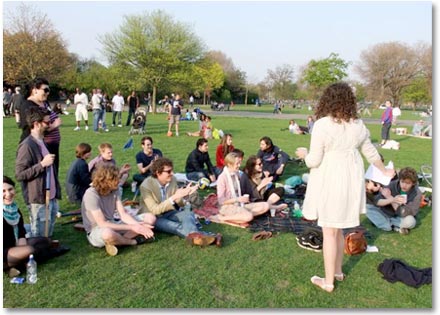
|
| HRH Miranda makes sure the club's meetings in Victoria Park are fun and not too long. |
Bob: I don't want to seem cynical or impertinent, but of course you are familiar with Hitler's comment about his generals: that the only decisions he allowed them make were the inconsequential ones. So I'll ask Matt is Queen Miranda's Counsel a consequential working body, or merely royal window dressing?
Matt Witt: One of the reasons that Croquet East is so brilliant is that each member brings their own personality and value to the table - whether it's useful contacts, ideas on how to promote the club, organisational skills, or a grasp of figures. We are all young, eager ambassadors for the club and we work in collaboration and for a common cause; combining our various specialisms to get as many people playing croquet as we can. The Croquet East Counsel is far from inconsequential. It's down to our team-work that the croquet bandwagon is becoming more heavily laden by the day. (In fact the self-claimed and over- indulgent title, HRH Queen Miranda, is the real window dressing!)
Bob: It was my impression that what Croquet East is really about is partying; and the croquet provides a focus, a reason for getting together on weekends. Many people join association clubs with regulation lawns for that very reason - purely as a social activity. I would think the social aspect would predominate in a club that meets on Saturdays in a park, and only when the weather is good, to play croquet on bumpy turf. So what, exactly, is this "croquet bandwagon" you speak of? How serious are your best players, at this point, in your first season?
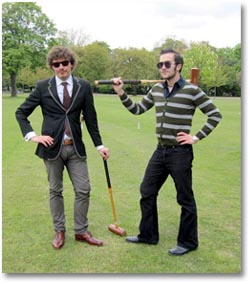
|
| Members get to choose their own dress standard, with whites seldom in evidence and boots preferred over court shoes. English weather encourages layering. |
Bob: Everybody comes out, even when it's raining and cold?
Matt: We are now in our second season, so the less committed have been weeded out. The level of skill within the club varies, but a few beacons of croquet talent make up the core. True, we don't have much to compare it with, but to put it in context, I often see our best players run hoops in two or three shots, on bumpy ground. What does that say about the level of croquet being played?
We take pleasure in bettering ourselves and are always eager to teach the less well practiced with the aim of improving their individual skills and in turn the standard of croquet played at the club in general. We are a competitive bunch, and games can get rather heated. The fact that we play on uneven ground does not make us any less committed to the game or our progress as players and as a club.
Bob: But what about the playing surface? How far can you advance without a good playing surface?
Matt: I realise that we can only go so far as players and as a club without a regulation lawn. Speaking personally I would relish the chance to start playing on a regulation lawn against some more seasoned players, and this is my intention before the season is out, whether with Croquet East or at one of the other London clubs. Croquet East is providing grass roots access to a new generation of players through an open and sociable approach, and I think it’s this that should be emphasised as the real value our model may bring to the modern game.
Bob: Matt, I couldn't agree with you more. In all my writings and workshops on club development, I emphasize the importance not only of the social factor, but of setting aside special times and places for "peer group" play and socializing. At the National Croquet Club - the world's largest facility, here in Palm Beach, which I organized and managed for its first three years - I established the Five-to-Nine Club especially for people who work in offices to come after hours and play Golf Croquet together once a week. The purpose was to establish a beach-head among younger people in a sport largely associated with elders, especially in South Florida. Which brings me to the question of what your "peer" group actually is. It seems to me that you're all youngish, and mostly associated with the arts. May I assume that you and HRH Queen Miranda and your counsel intend to preserve that focus on young artists and their friends?
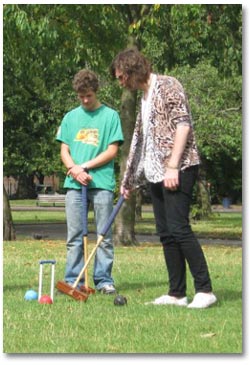
|
Matt: Smashing idea.
Bob: I hate to sound disrespectful, your majesty, and I don't doubt that you are growing a cadre of enthusiastic players, but I don't think you should contemplate any scientific breakthroughs until you have members who can run an all-round break - that is, scoring all the hoops in one turn, which would be especially difficult on rough turf. So let me ask you both now: What's the longest break you've witnessed by one of your members in Croquet East play in the park, in your second season?
Matt: We play Golf Croquet, so it's difficult to answer that question. Our best player can run hoops in two or three shots. Would you like to know why we play Golf Croquet?
Bob: Let me guess! Because it's easy to learn and fast-moving, so lots of people can get court time. And you can play more than one game on the court, since each hoop is contested in order. And of course, playing a simple game makes it easier to recruit new players. Right so far?
Matt: Yes, all correct so far.
Bob: It's the conventional wisdom of most clubs in the US and also throughout the British Commonwealth, to introduce the sport via Golf Croquet. And thanks to the Egyptians, who still rule the Golf Croquet rankings (despite their first loss ever in this year's World Championship) the game is now at last seen as a "respectable" alternative to Association Croquet.
Now give me a picture, if you can, of what the activity in Victoria Park looks like on a good day, after her majesty has announced an event there. How many people show up? How many courts? How many games going at the same time? And do you usually play doubles, for the sociability factor as well as space efficiency?
HRH Miranda: On a lovely sunny day we generally get around 40 people popping along. Unfortunately we only have one set of Jaques hoops, (donations for a second set more than welcome), but we're pretty nifty and can squeeze three games - twelve people - onto one court at once. We do usually play doubles, but it completely depends on what people fancy on the day. We've done lots of super fun things this summer, including themed tournaments, sports days and charity events, and we have a lot of festivals lined up.
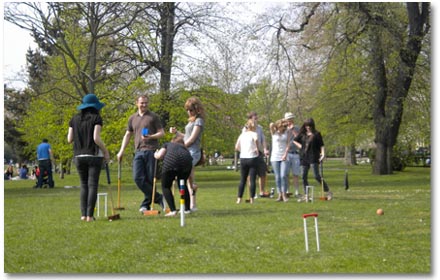
|
Bob: If you do charity events, you raise money for other enterprises, but do you have club membership dues or other income of your own, which you could use to buy sufficient equipment to allow forty people to play simultaneously? What's the financial foundation of the club?
HRH Miranda: None of us have much money, so we try to keep membership and dues as low as possible. We charge £10 a year for membership and ask for occasional donations as and when we need things. We definitely don't have enough money to buy more equipment though. We have barely enough to be getting on with at the moment.
Bob: But you're not completely a club of "starving artists!" You've said that you have doctors and lawyers among the member mix - but of course they're young like you and Matt, so I suppose they couldn't be expected to finance the club. I believe your first set of hoops was donated by the Croquet Association; surely you intend to get more equipment, because it's hard for a one-lawn club to expand, and my impression is that Croquet East intends to grow a lot. Am I right?
HRH Miranda: We're absolutely not all starving artists but we are all young - and living in London is expensive. We'd love to get more equipment eventually, but our real focus at the moment is petitioning the City Council to give us our own dedicated lawn. Once we have that sorted, then we will worry about expansion, equipment and potential world domination.
Bob: Have you chosen a likely site in Victoria Park?
HRH Miranda: Victoria Park would be ideal and there is certainly plenty of space there, but unfortunately we have to wait for the Council to get funding for it, which might not be for a few years. The only agreement with the park now is that they cut our designated area for croquet shorter than the surrounding grass.
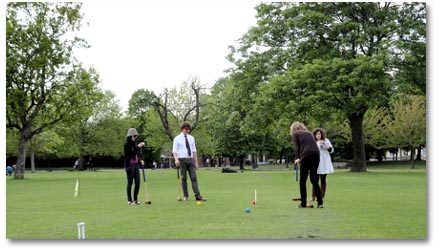
|
| The grass in Victoria Park makes a surprisingly good surface when it's cut short. |
Bob: I've found in establishing new clubs on public turf in the United States that it's helpful to enlist a "champion" of your cause within the system - in your case, that would be the City Council - with whom you could partner to select an ideal site that not only serves your purpose but fulfills some special need of the Council. For example, if you and the Council member who champions your cause could agree on an area of the park that is under-used or mis-used and which actually needs the presence of an organized group to restore it to useful public service, that Councilman might be more willing to fast-track your funding. Is there any reason why that kind of partnership of public and private interests wouldn't work as well in London as it does in California in San Francisco and Oakland and Beverly Hills and Pasadena?
Matt: Funding in general is an issue in the UK at the moment. The recent economic downturn has led to a lot of cuts, making it harder to obtain funding for everyone (most notably the arts but also affecting other sectors) and especially for projects which may be considered a luxury. The park is currently undergoing a massive improvement project as part of the regeneration of East London for the Olympics in 2012. This is another reason that any funding for further development within the park may be difficult to obtain. We missed the boat on that one.
Bob: Are you sure? Tight funding gives you an opportunity to pitch SHARED use to municipal entities - with bowlers, for example. The bowlers resist sharing, of course, but on the other hand would be pleased to see people under 60 drawing attention to their facility - IF the politics is handled right. The lawns must not be damaged, and the croquet players would allow the bowlers to have first dibs on playing times. Most city fathers are very attracted to efficient use of public facilities, especially in these times when money is tight. This formula has been most successful in Canada, but has also been applied in almost all the other croquet-playing countries, including Australia and the United States. Have you considered that approach?
Matt: I'm not in a position to comment further on this subject. Miranda? Is my last answer even accurate? Why do you think the Egyptians dominate so much?
Bob: I'll answer the Egyptian part - and this is thoroughly covered by CROQUET WORLD in several articles. Briefly, Golf Croquet is the only game the Egyptians have played since they threw the Brits and French out in the 50's and took over their residential compounds along with their sports facilities. The Egyptians have made Golf Croquet respectable in the croquet world, because nobody can beat them. Over to you, Miranda!
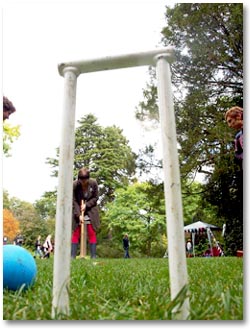
|
Bob: Of course the bowlers don't want to share. They never do. The Council would have to break that particular log-jam with economic pressure. But the only place I see that you're really "stuck" is the notion that you require "good lawns." Need I point out that your inspiration for Croquet East was the traditional form of "garden croquet" tremendously popular during the reign of Queen Victoria, and which was played on any turf available? That's what you're doing now, in Victoria Park. The only difference is that you are wise enough to be playing Golf Croquet, so you can host lots of games simultaneously in a small space. I propose that what you REALLY need next is more equipment - hoops and balls of virtually any standard - in order to accommodate more players in Victoria Park. I'm aware that the Croquet Association donated heavy, professional hoops; but surely you could get by with lighter and less expensive hoops, especially for new or lower-ranked players. That wouldn't bust your budget. Wouldn't that be the best development approach at this stage?
HRH Miranda: That's certainly an idea - although where we'd store any more equipment might be a problem. Our flat's bursting with mallets as it is! We'll have to mull all these ideas over at our next meeting. We're a bit busy with festivals at the moment, but will have a good old thing this summer about how we can successfully develop.
Bob: One measure of seriousness is whether a member has his or her own mallet. So you don't necessarily need more club mallets. What you really need is more hoops and court settings. Several full court settings could fit easily into just a corner of the trunk of somebody's car - especially if you have light-weight "winter wickets" which I think would be entirely sufficient at this level of development. Alternatively, you could work with the Victoria Park staff to find a small locked closet to store your equipment - which would advance your relationship with officialdom. Third choice - a bit more expensive - is to set a heavy locked equipment bin at a likely spot on the lawns, where anyone with a key could get at it and return the equipment after play. This has been done for at least two of the facilities I've organized in California, both in public parks, and both with locked equipment boxes by the lawns. So might you explore all those equipment ideas in your meeting also?
[EDITOR'S NOTE: At this point Matt and Miranda disappeared for a week, and I sent them an inquiry.]
HRH Miranda: Many apologies for the delayed response - we've been away for a week teaching croquet at a festival. We taught about 500 people to play in one weekend and are hence a bit exhausted! We will definitely be looking into ways the club can develop - both equipment-wise and lawn-wise. We're meeting our Croquet Association mentor in a couple of weeks (he's popping back to teach some of our regulars Association rules), so we'll ask him what he thinks is the best option for us.
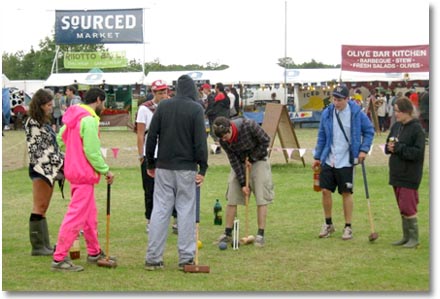
|
| Festivals are prime targets for London East's "missionary" outreach. |
Bob: I've been told your mentor and AC coach is David Collins. Association Croquet on rough turf in Victoria Park will be interesting, at the least. But I'm more interested in your 500 "students," to whom I assume you taught Golf Croquet. Please describe the circumstances: the festival, the people (young people, I presume?) and the playing surface. More important: how do the festival excursions fit into the expansion or further development of your majesty's London East empire?
HRH Miranda: Our mentor is indeed David Collins (or 'the silver fox' as he's known to us). He seems convinced that while some shots will be tricky, we'll be able to get a good feel for Association rules in the park. The festival was called Secret Garden Party and we did play Golf Croquet. It's in Cambridgeshire and describes itself thus:
"The Secret Garden Party is a temporary community that is as free, irreverent, friendly and engaging as it is possible to be. It is conceived as a moment in the year where you can connect to your creative powers, explore your wildest fantasies and meet thousands of people who all want to meet you. It is a gathering that exists for only four days - away from cities and schedules, brands and boundaries – founded on participation and with the potential to change your life. It is a festival of the arts…where everyone is the artist."
The crowd is varied - mostly young people, also a lot of families, and we had all ages playing over the weekend. We're trying to go to a couple of festivals each year - obviously this is partly to promote the club (we get a lot of new members from each event we attend), but also to promote croquet in general. Croquet East aims to spread the joy of croquet to all and sundry, and the more people we can introduce to the game, the better. I've attached a couple of photos so you can see for yourself what we got up to.
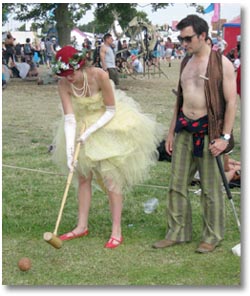
|
| Festival crowds attracted to Golf Croquet get to use heavy hoops, professional mallets, and world-class balls on rough turf. |
HRH Miranda: Our vision is to bring style and youth back to the game of croquet - to get as many young people as possible playing and make croquet once again the fashionable social phenomenon it was in the 19th century. We're hoping the club will continue to expand organically and would love to inspire other young people to set up their own clubs in other parts of the country. We want people to realise that you don't need a perfect lawn and oodles of equipment to enjoy the game - a local park is fine as long as you have lots of enthusiasm. We'd also love to inspire some of the older clubs to reassess their approach - for example, to start adopting digital media as a means of promotion and think a bit more about the aesthetic they're presenting. I have no idea how Croquet East will look in five years, but I intend to have a jolly good time finding out.
Bob: I would strongly recommend creating a communal vision with discrete goals that you can put into a timeline. That actually works to align members in moving towards common goals; and it inspires potential partners (like the local Council) to come to your aid, once they know exactly what you want and how it contributes to their own causes. However, when you're breaking up a longstanding "reality" (about what croquet clubs are and what they ought to be) I acknowledge that it also works to start things moving and then just ride the tide you've created. And I admit that could be more fun. The important thing is that your club has great potential on its own merits and could even influence the evolution of a sport with a stuffy image and skewed demographics. I've talked a lot and delivered lots of opinions, so it's only polite now to thank you and Matt for the interview and give you the last word by asking: What question would you like to answer that I haven't asked?
HRH Miranda: No questions from me, you've been extremely thorough.
Some entries from the Croquet East art contest
A vast variety of artists, styles, and themes emerged from the club's highly successful Croquet Art Contest. Here are a few of the entries, published by permission of the artists, with links to their websites.
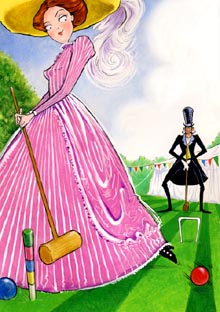
|
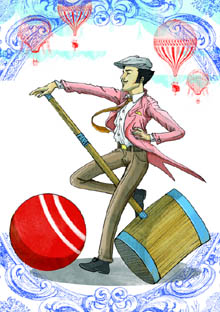
|
| "Researching the history of croquet in the Victorian era, I read that it was common practice for ladies to kick their opponent's ball off course, under cover of their massive shirts." Liz Monahan. | "We illustrate the fun spirit of Croquet with a character who loves having a good time and not taking himself too seriously." YesGo Studio (Rukmunal Hakim & Juliana Tjitra) |
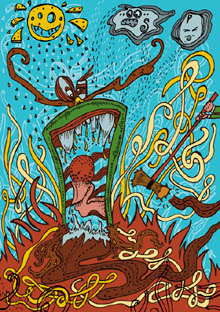
|
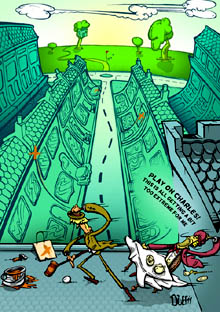
|
| "For some reason thinking of Croquet whilst eating the pasta made me think of meatballs and I thought it would be fun to relate the two." Nikki Pinder. | "Imaginary Croquet" by David Blatch, Courageous Illustration. |

|

|